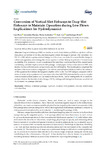Conversion of Vertical Slot Fishways to Deep Slot Fishways to Maintain Operation during Low Flows: Implications for Hydrodynamics

Use este enlace para citar
http://hdl.handle.net/2183/35624Colecciones
Metadatos
Mostrar el registro completo del ítemTítulo
Conversion of Vertical Slot Fishways to Deep Slot Fishways to Maintain Operation during Low Flows: Implications for HydrodynamicsFecha
2018Centro/Dpto/Entidad
Enxeñaría da Auga e do Medio Ambiente (GEAMA)Cita bibliográfica
Pena, L., Puertas, J., Bermúdez, M., Cea, L., & Peña, E. (2018). Conversion of vertical slot fishways to deep slot fishways to maintain operation during low flows: Implications for hydrodynamics. Sustainability, 10(7), 2406. https://doi.org/10.3390/su10072406
Resumen
[Abstract:] Deep slot fishways (DSF) are similar to vertical slot fishways (VSF) except that a sill has been placed at the base of the slot, and thus require a lower discharge to operate. The conversion of a VSF to a DSF, which requires minimal design modifications, can make for a more flexible design in inflow management, maintaining the correct operation of the fishway in periods of limited water availability. It is, however, crucial to understand the new flow conditions that will be created inside the fishway, and their implications for fish passage. In this paper, the hydrodynamics of DSF were studied for two different pool configurations and five sill heights. The investigation comprised the analysis of the water surface configuration, the velocity and turbulence fields, as well as the definition of the equations that related discharges to depths in the pools. The DSF designs compared well in terms of water surface patterns and maximum velocities with VSFs, but resulted in a more complex three-dimensional flow pattern and increased turbulence levels. Further testing with fish is needed to analyze whether the benefits of retrofitting a VSF by adding a sill during low flows are cancelled out by increased fish passage difficulty.
Palabras clave
Fishway
Upstream passage
Hydraulic models
Flow patterns
Velocity distribution
Turbulent flow
Upstream passage
Hydraulic models
Flow patterns
Velocity distribution
Turbulent flow
Versión del editor
Derechos
Atribución 3.0 España






